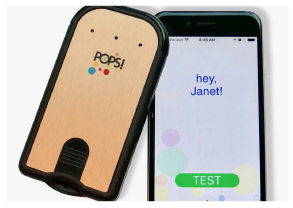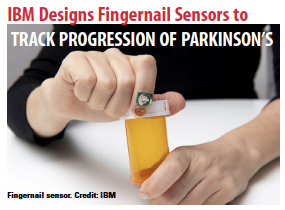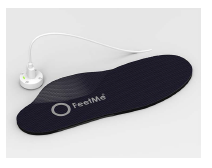POPS! Blood Glucose Test Attaches To Smartphone
Trend Watch: Medical Devices Support Patient Monitoring from Head to Toe
 Minneapolis-based POPS! Diabetes Care received FDA clearance for its blood glucose monitoring system that can be adhered to the back of a smartphone. Readings are taken via built-in needles that prick the thumbs, and a sensor absorbs a drop of blood for processing. The overall process takes about 30 seconds from beginning to results.
Minneapolis-based POPS! Diabetes Care received FDA clearance for its blood glucose monitoring system that can be adhered to the back of a smartphone. Readings are taken via built-in needles that prick the thumbs, and a sensor absorbs a drop of blood for processing. The overall process takes about 30 seconds from beginning to results.
Readings are immediately shared and displayed on the phone. The POPS! one System includes a coaching app for analyzing readings and helping get blood sugar levels under control.
POPS! Diabetes Care, which was named a Pepperdine Graziadio Business School Most Fundable Company, is preparing for commercialization in early 2019. “We are thrilled to have successfully worked with the FDA to clear this novel solution for people with diabetes. POPS! is delivering a simple experience to help people take action to achieve their goals," says Lonny Stormo, CEO of POPS! Diabetes Care.
New Sensor Detects HER-2 Breast Cancer Biomarker In 15 Minutes
 Researchers at the University of Connecticut and University of Hartford have developed an inexpensive biosensor that detects HER-2 in a small whole blood sample within 15 minutes.
Researchers at the University of Connecticut and University of Hartford have developed an inexpensive biosensor that detects HER-2 in a small whole blood sample within 15 minutes.
The achievement relied on using an inkjet printer to put down a nanoparticle ink onto a plastic substrate, in the process producing a specialized electrode array chip. The chip has antibodies coating the electrodes that capture HER-2 proteins. The chip works in conjunction with a microfluidic device that controls the flow of the blood sample through the chip, and after the blood is passed through, a special liquid is injected and an electric current passed through. The measured current across the chip varies slightly whether there are HER-2 proteins attached or not, providing an indication of the blood test.
“Less invasive, more accessible, and faster diagnostic tools like this biosensor are essential to improving healthcare," says Seila Selimovic, Ph.D., director of the National Institute of Biomedical Imaging and Bioengineering programs in Biosensors and Physiological Detectors program, the organization that sponsored much of the research. “As biosensors continue to progress it is important to keep in mind diagnostic tools are only helpful when accurate. This biosensor works in the clinically relevant range and has one of the lowest reported HER-2 detection limits, so fewer false positives and negatives will occur."
These easily fabricated and scalable electrochemical sensor platforms can be readily adapted for multiplex detection following this rapid assay protocol for cancer diagnostics.
IBM Designs Fingernail Sensors to Track Progression Of Parkinson’s
 The IBM team designed tiny fingernail sensors to help clinicians detect and monitor the progression of disease via AI analysis and grip strength. According to the IBM blog, grip strength is a useful metric in a surprisingly broad set of health issues. It has been associated with the effectiveness of medication in individuals with Parkinson’s disease, the degree of cognitive function in schizophrenics, the state of an individual’s cardiovascular health, and all-cause mortality in geriatric patients.
The IBM team designed tiny fingernail sensors to help clinicians detect and monitor the progression of disease via AI analysis and grip strength. According to the IBM blog, grip strength is a useful metric in a surprisingly broad set of health issues. It has been associated with the effectiveness of medication in individuals with Parkinson’s disease, the degree of cognitive function in schizophrenics, the state of an individual’s cardiovascular health, and all-cause mortality in geriatric patients.
The first-of-a-kind fingernail sensor prototype is a wearable, wireless device that continuously measures how a person’s fingernail bends and moves, which is a key indicator of grip strength.
The device (pictured) is comprised of two components. The first is a compact computer that sits atop a user’s finger, while the other is an array of strain gauges meant to be attached to the fingernail. The strain gauges record the subtle ways the fingernail moves and changes its shape as wearers use their hands.
The current iteration of the sensor is designed to be used with a smartwatch. The smartwatch processes the data using artificial intelligence algorithms that IBM has developed specifically for the project.
According to the company, its AI can not only identify abnormal movements but also distinguish between different activities. The software is accurate enough to tell, among other things, if the user is writing and even determine when they’re drawing numerical digits. The granularity could potentially enable the sensor to double as a communications aid for people with disabilities.
All the details of the health monitor prototype can be found in Scientific Reports under “Wearable Nail Deformation Sensing for Behavioral and Biomechanical Monitoring and Human-Computer Interaction."
First Accredited Continuing Medical Education Course Filmed In VR
For the first time, a 360-degree virtual reality (VR) Continuing Medical Education (CME) accredited course in GI surgery is available for streaming to surgeons and medical professionals. The course is a collaboration between medical experts at Cedars-Sinai and GIBLIB, the streaming media platform offering the largest library of on-demand medical lectures and surgical videos in the newest formats.
While viewing the procedures on a VR headset, course attendees experience a fully immersive panoramic perspective of the operating room complete with multiple angles, including digital overlays such as patient imaging and laparoscopic and robotic camera feeds.
“Virtual reality allows viewers to be fully immersed in the operating room without having to travel across the world for specialized training," says Miguel Burch, M.D., chief of minimally invasive and GI surgery at Cedars-Sinai. “This efficient, innovative technology provides an online, backstage pass for trainees anywhere."
Healthcare professionals can access the course by subscribing to giblib.com.
Bluetooth-Powered Smart Electronic Pill Releases Drugs On Demand
Researchers at MIT, Draper, an engineering firm, and Harvard’s Brigham and Women’s Hospital have developed an electronic wireless device that can stay inside the gut for long periods of time while releasing drugs into the body and measuring various parameters. The device has Bluetooth connectivity built in, and it can share its readings and trigger the release of a drug via a coupled smartphone app.
The swallowable device can stay in the body for over a month and it can be manufactured to different specifications since it’s 3D-printed. Moreover, it can be programmed so that the measurements that its sensors make can trigger a drug to be administered, allowing for immediate treatment of symptoms of allergies, infections, and other conditions.
“Our system could provide closed-loop monitoring and treatment, whereby a signal can help guide the delivery of a drug or tuning the dose of a drug," says Giovanni Traverso, a researcher involved in a study published in journal Advanced Materials Technologies.
Once the device is swallowed, which initially looks like a pill, its arms unfold and prevent it from exiting the stomach. After about a month or so, the arms break off and the individual parts of the device can safely exit the body.
Novartis Teams Ups With FeetMe to Create Measurement Device for MS Progression
 Novartis and the smart medical devices firm FeetMe are collaborating on the development of portable insoles that measure progression in patients with multiple sclerosis (MS). This is a unique trial being run by Dr. Guillermo Izquierdo, head of the EM Research and Treatment Unit of the Vithas Nisa Foundation, and developed exclusively at the Vithas Nisa Sevilla Hospital, which recently achieved the first inclusion of patients, from a total sample of 208.
Novartis and the smart medical devices firm FeetMe are collaborating on the development of portable insoles that measure progression in patients with multiple sclerosis (MS). This is a unique trial being run by Dr. Guillermo Izquierdo, head of the EM Research and Treatment Unit of the Vithas Nisa Foundation, and developed exclusively at the Vithas Nisa Sevilla Hospital, which recently achieved the first inclusion of patients, from a total sample of 208.
The main objective of the project is to contribute to the mobility of patients through the analysis of movement and posture in real time and conditions of life, through the coordination of pressure and movement sensors and the use of reinforced learning algorithms.
This allows analysis of the functional capacity of the patients and provides a rehabilitation tool to those who suffer gait disorders, which often constitute a precursor and indicator of MS.
Both companies, with the unconditional support of the Vithas Nisa Foundation, are committed to creating a connected template and associated software to measure plant pressure and space-time gait parameters, as well as technologies to monitor patient data in real time, detect biological and behavioral changes, improve patient adherence, and ultimately, improve treatment outcomes.
FeetMe is a Paris-based medical device start-up company developing movement analysis solutions based on connected insoles with applications in the monitoring of neurodegenerative diseases, as well as rehabilitation and physical therapy. FeetMe Monitor, its first product, is CE mark and commercially available.
FeetMe devices combine embedded and miniaturized sensors with smart algorithms to assess mobility in real world non-invasively.(PV)



















